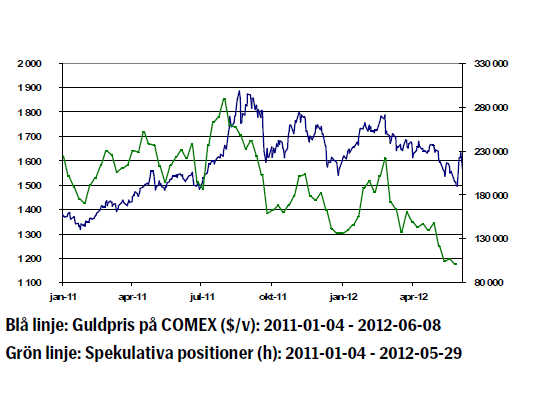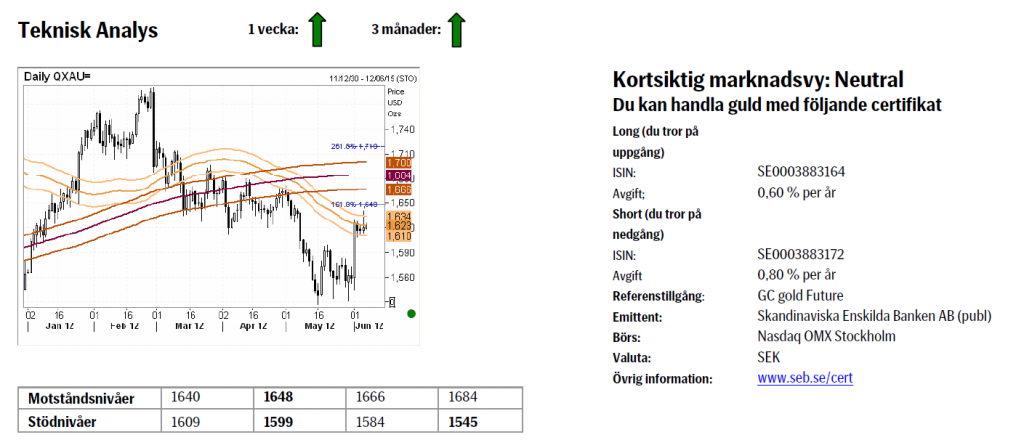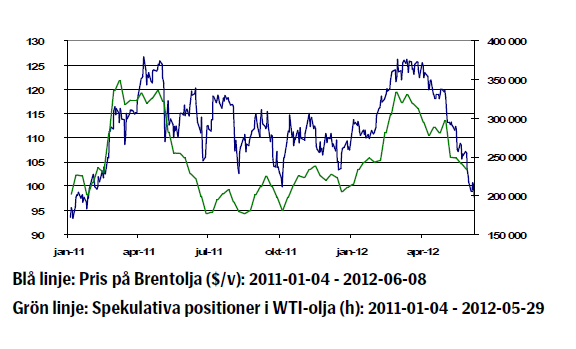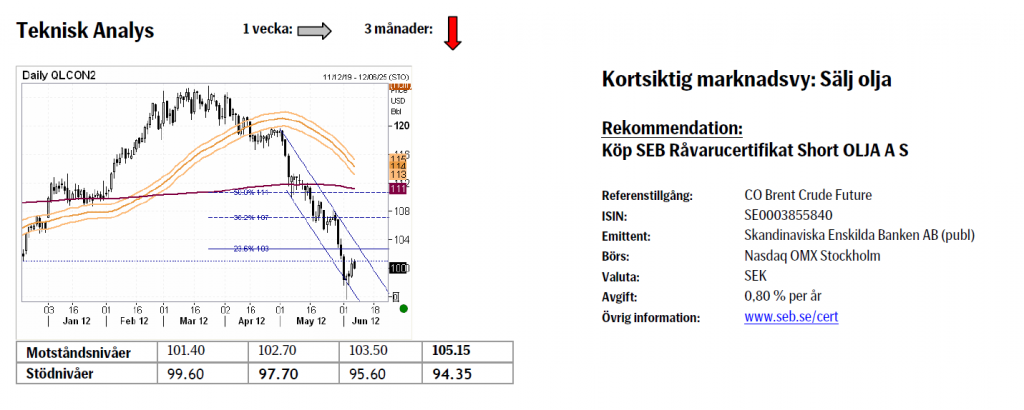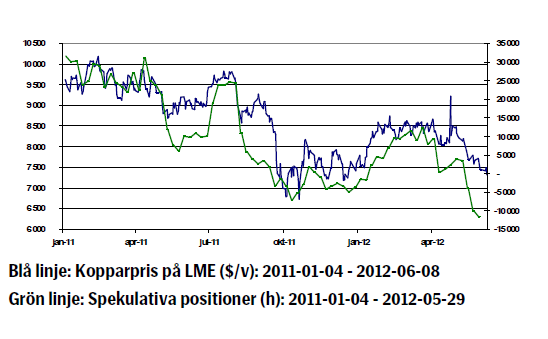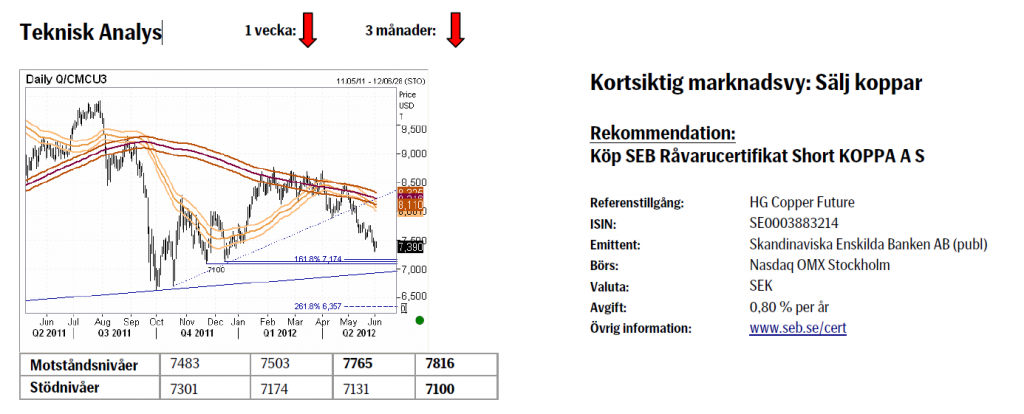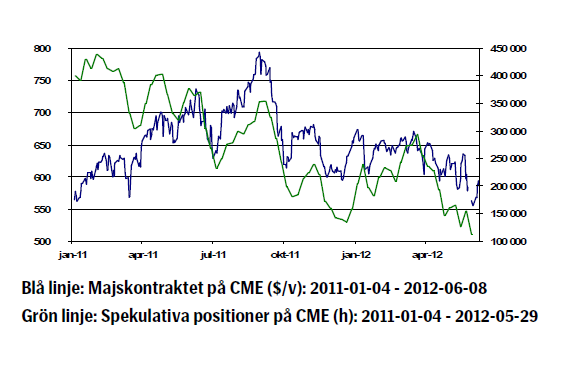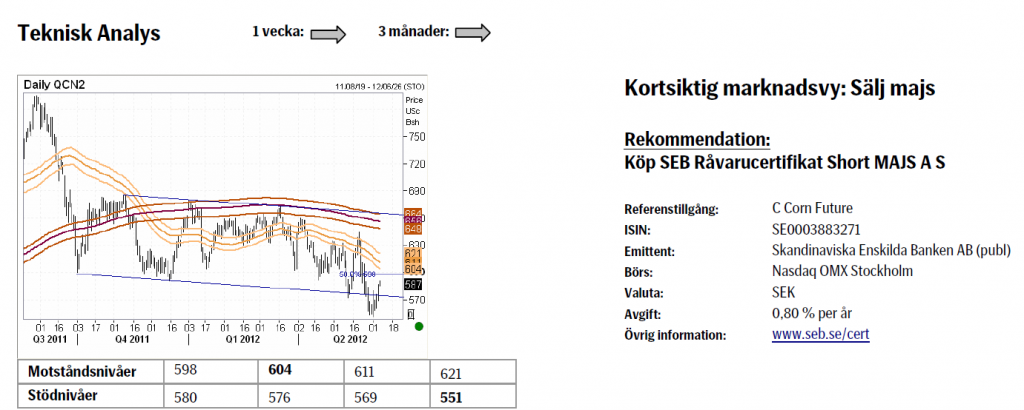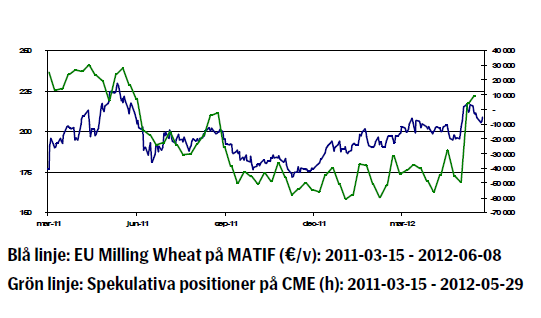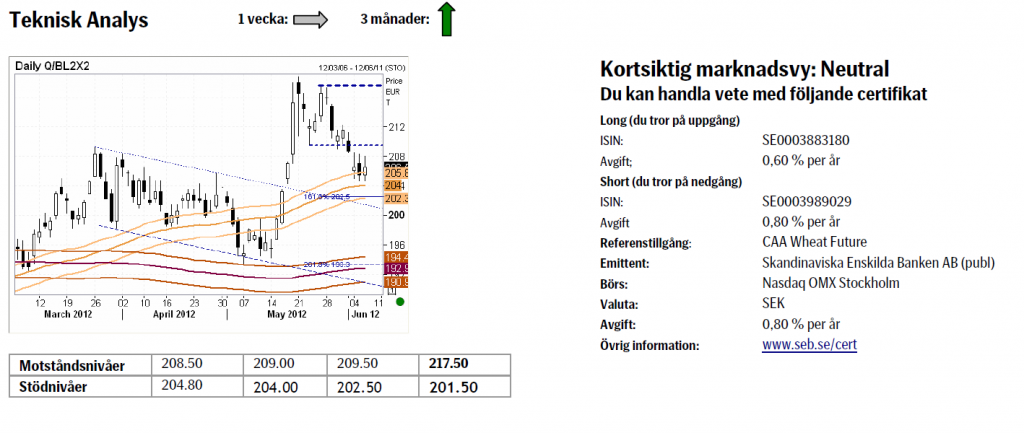Analys
SEB – Råvarukommentarer vecka 23 2012
Sammanfattning:
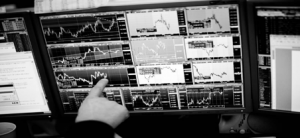 Brett råvaruindex: + 0,35 %
Brett råvaruindex: + 0,35 %
UBS Bloomberg CMCI TR Index- Energi: – 1,02 %
UBS Bloomberg CMCI Energy TR Index - Ädelmetaller: – 2,85%
UBS Bloomberg CMCI Precious Metals TR Index - Industrimetaller: – 0,47 %
UBS Bloomberg CMCI Industrial Metals TR Index - Jordbruk: +3,13 %
UBS Bloomberg CMCI Agriculture TR Index
Kortsiktig marknadsvy:
- Guld: Neutral
- Olja: Neutral/sälj
- Koppar: Sälj
- Majs: Sälj
- Vete: Neutral
Guld
Guldpriset steg som en reaktion på ökade QE3-förväntningar p.g.a. svaghet i den amerikanska arbetsmarknaden. Dollarn försvagades också efter fredagens dåliga jobbsiffror.
Igår, torsdag, talade Bernanke inför den amerikanska kongressen och marknaden lyssnade lyhört efter tecken på kvantitativa lättnader dvs. mera pengar i omlopp. Inget konkret kom ur mötet mer än att Fed står redo att stimulera om så krävs vilket fick guldet att falla tre procent.
En ökad penningmängd driver på guldpriset men även andra ”risky assets” såsom råvaror generellt och aktier. Idag faller guldet p.g.a. bristen på antydningar om kvantitativa lättnader och vi fortsätter ha en försiktig hållning till guldet efter den snabba rekylen efter förra veckans rally.
Oron kring den spanska ekonomin ökar. Landets tioårsränta har legat fem procent över den tyska motsvarigheten i nio dagar nu. Igår sålde spanska staten obligationer för två miljarder euro. Den 10-åriga stadsobligationen gav en ränta på 6,044 procent. Oron för Europa och Spanien ger stöd åt guldpriset.
Europeiska centralbanken lämnade på onsdagen styrräntan oförändrad på en procent. Draghis kommentarer efter beskedet tydde på att europeiska centralbanken önskar politiska initiativ för att möta de problem som eurozonen står inför.
Teknisk analys: I en kraftig uppgångsfas. Den större bilden har blivit ytterligare stärkt av den kraftiga uppgång som noterades i förra veckan. Viss respekt visas den över delen av 55- dagars bandet, men en rörelse ner mot 1609/1599 ska ses som korrektiv och ska köpas. En dagsstängning över bandet, nu vid 1634 och brott över en projektionsnivå vid 1648 skulle höja ribban för ett test också in i 233-dagars bandet som just nu börjar vid 1666.
Olja
Fallande råvarupriser inledde veckan efter fredagens svaga jobbsiffror från USA. Oljepriset, vilket fallit cirka tio procent den senaste veckan, drogs även ned av skuldoro i Europa och tecken på konjunkturavmattning i Kina.
Opec-länderna håller möte den 14 juni och på agendan kan förväntas en diskussion kring produktionsnivåer. Opec:s kvoter tillåter idag en produktion på 30 miljoner fat per dag men Opec:s medlemmar producerar runt 31,5 miljoner fat per dag. Saudiarabien som länge önskat ett oljepris på100 dollar har producerat mer än man gjort på decennier, detta i avsikt att få bättre effekt av sanktionerna mot Iran.
FN:s säkerhetsråd + Tyskland möter Iran igen den 18-19 juni och förhoppningarna är stora att man ska finna en lösning på den rådande konflikt som bottnar i misstankar om att Iran tillverkar anrikat uran i kärnvapensyfte.
American Petroleum Institute (API) redovisade på tisdagen att råoljelager sjönk ~1,2 miljoner fat förra veckan, vilket är fem procent högre jämfört med föregående år. Siffror från DOE visade att råoljelager sjönk marginellt samtidigt som lager för oljeprodukter steg.
Driving season i USA startade officiellt i samband med Memorial Day förra veckan och man kan nu förväntas se en ökning i efterfrågan av oljerelaterade produkter. Vi har svårt att se ett mycket högre oljepris på kort sikt man har man en något längre tidshorisont kan nuvarande nivåer vara intressanta att gå in på.
Teknisk analys: Korrektiv rörelse högre att vänta Även ett fritt fall tar någon gång slut. Den kortsiktigt överdrivna rörelsen ner mot $95.60 i måndags korrigeras nu och detta kan fortsätta upp mot första korrektionsmålet (23.6%) vid $102.70, möjligen också mot den fallande motståndslinjen, nu vid $103.50, eller t.o.m. mot gamla stödet vid $105.15. Tillbaka under $97.70 skulle omintetgöra möjligheterna till vidare uppgång i ett kortsiktigt perspektiv, utan i stället ställa om siktet mot höstens botten vid $94.35.
Koppar
London Metal Exchange (LME) var stängd måndag och tisdag p.g.a. helgdagar. Skuldoro i Europa och flera tecken på en konjunkturavmattning i Kina har länge lagt sordin på kopparpriset.
Kinesisk statistik har varit svag på sistone. Ökningen i industriproduktionen för april landade på drygt nio procent på årlig basis vilket är den sämsta siffran på tre år. Nyutlåningen till banker föll med 33 procent i april jämfört med mars i år. Mycket talar för att siffran blir ännu sämre för maj. Nyutlåningar är i nära kopplad till investeringar i fasta tillgångar som föll till ett 10-årslägsta i april.
För att möta inbromsningen sänkte igår kinesiska centralbanken räntan på ettåriga lån med 25 punkter, en sänkning som träder ikraft idag. Den ettåriga räntan ligger nu på 6,31 procent. Kopparpriset reagerade positivt på denna nyhet och steg med 1,20 procent på beskedet. Uppgången var kortvarit och hela uppgången från igår är idag borta. På kort sikt tror vi dock att vi kan se lägre priser.
Söndagen en 17:e juni går Grekland till val vilket handlar om huruvida det grekiska folket ska gå med på åtstramningar i utbyte mot nya krislån eller istället kräva att överenskommelsen med EU/IMF/ECB rivs upp. Det senare skulle med största sannolikhet leda till att Grekland tvingas lämna euron. Grekisk lag förbjuder publicering av opinionsmätningar två veckor före valdagen vilket ökar ovissheten.
HSBC:s index för tjänstesektorn steg till 54,7 i maj jämfört med 54,1 föregående månad och kinesiska företag är fortsatt optimistiska om framtidsutsikterna. Indexet är konstruerat så att värden över 50 innebär ekonomisk expansion. Index för tjänstesektorn står i skarp kontrast till motsvarande undersökningar för industrisektorn som visade att Kinas industri slog av på takten i maj. Kinas tjänstesektor står nu för hela 43 procent av ekonomin.
Teknisk analys: På väg mot $7174/7100. Den noterbara nedgången fortsätter med största sannolikhet ner mot nästa målområde som börjar med en projektionsnivå vid $7174, som sedan följs av botten som noterades i november förra året vid $7100 och därefter en mera långsiktig stigande stödlinje i $7000-området.
Majs
Majspriset Priset på decembermajs har varit stabilt pga. oro över det ovanligt torra vädret i USA samt obekräftade uppgifter om inköp av majs från Kina. En förväntad rekordproduktion i Brasilien och fortsatt goda skördar i USA fick dock priset att falla tillbaka i början av veckan.
Marknaden förväntade sig en försämring av kvalitén på majsskörden i USA men måndagens rapport från USDA uppvisade inga förändringar från föregående vecka utan good/excellent kvarstår på 72 procent vilket är väldigt högt.
USA:s majsskörd förväntas bli god och förväntas fylla på lager vars nivåer varit låga p.g.a. dåliga skördar föregående år.
Konsumtionen av majs till etanol har fallit p.g.a. att subventioner på inblandning i bensinen tagits bort från årsskiftet, vilket ytterligare tynger majspriset. På tisdag, den 12 juni, kommer USDA´s viktiga WASDE (World Agricultural Supply and Demand Estimates) rapport: Prognoserna för utbud och efterfrågan på majs förväntas höjas.
Trots torka så har prognosen för Brasiliens majsproduktion reviderats upp till rekordhöga 67,79 miljoner ton, jämfört med 65,9 miljoner ton för en månad sedan. Stämmer siffrorna så kommer det att vara första gången på över 10 år som Brasilien skördar mer majs än sojabönor. Goda skördar och gynnsamt väder gör att vi är fortsatt negativa till majspriset.
Teknisk analys: Återtest av tidigare stöd. Marknaden har klättrat tillbaka in i det tidigare stödområdet (som nyligen penetrerades). Vidare uppgång möter sannolikt motstånd närmare den lägre delen av det fallande 55-dagars bandet, nu vid 604.
Vete
Det europeiska Matifvetet med novemberleverans föll tillbaka i fredags och bröt igenom stödnivån på 210 EUR. Förbättrade väderutsikter i Europa och Svartahavsområdet tillsammans med svag makrostatistik drog ned priset på kvarnvetet som sedan dess har pendlat mellan stödnivån 205 EUR och 208 EUR.
Kontrasterna i Europa har varit stora veckan som gått med varmt torrt väder i de västra delarna och kallt och regnigt i öster. I Frankrike och England har den senaste tidens regn främjat höstgrödornas utveckling, men också gett upphov till ökad risk för sjukdomar. Även Tyskland, Polen och norra Balkan har fått välbehövligt regn (10-35 mm) medan det torra och varma vädret i Italien och Spanien har gynnat skörden av vete.
Måttliga regnskurar har förbättrat utsikterna i de veteproducerande områdena i södra Ukraina och i de södra delarna av Rysslands södra distrikt.
Prognosen för veteproduktionen inom EU-27 har reviderats ned med 200 000 ton till 126,5 miljoner ton, främst på grund av lägre förväntad avkastning i Tyskland, Bulgarien och Rumänien. Tyska lantbrukarna har återigen fått uppleva en torr vår, efter förra årets vår med extremt låg nederbörd. Tysklands spannmålsskörd förväntas i detta skede att hamna under landets genomsnittliga årliga produktion men rikliga regn under de kommande dagarna och veckorna kan fortfarande bidra till en positiv utveckling.
Crop condition för vintervetet i USA, som rapporterades i måndagskväll ligger nu på 52 procent good/excellent och det är TVÅ procent lägre än förra veckan. Nivån är emellertid bra och jämfört med förra året är den t.o.m. mycket bra. Skörden av vintervete i USA går betydligt fortare fram än vanligt. Utsikterna för veteskörden ser fortsatt bra ut och vi behåller vår neurala syn.
Teknisk analys: Utdragen korrektion Den pågående korrektionen lägre har tagit en djupare bana och kan möjligtvis bli mer komplicerad än vad som tidigare varit antaget. Stöd återfinns dock i 55-dagars bandet (€205.80/202.30), vid en projektionsnivå vid €202.50 och vid den tidigare brutna (fallande) motståndslinjen, nu vid €201.50. Under den senare skulle ifrågasätta om det bara är en korrektion eller om det är något större i görningen (då det skulle öppna också för ~€195). Tillbaka över €209.50 skulle minska trycket på nedsidan.
[box]SEB Veckobrev Veckans råvarukommentar är producerat av SEB Merchant Banking och publiceras i samarbete och med tillstånd på Råvarumarknaden.se[/box]
Disclaimer
The information in this document has been compiled by SEB Merchant Banking, a division within Skandinaviska Enskilda Banken AB (publ) (“SEB”).
Opinions contained in this report represent the bank’s present opinion only and are subject to change without notice. All information contained in this report has been compiled in good faith from sources believed to be reliable. However, no representation or warranty, expressed or implied, is made with respect to the completeness or accuracy of its contents and the information is not to be relied upon as authoritative. Anyone considering taking actions based upon the content of this document is urged to base his or her investment decisions upon such investigations as he or she deems necessary. This document is being provided as information only, and no specific actions are being solicited as a result of it; to the extent permitted by law, no liability whatsoever is accepted for any direct or consequential loss arising from use of this document or its contents.
About SEB
SEB is a public company incorporated in Stockholm, Sweden, with limited liability. It is a participant at major Nordic and other European Regulated Markets and Multilateral Trading Facilities (as well as some non-European equivalent markets) for trading in financial instruments, such as markets operated by NASDAQ OMX, NYSE Euronext, London Stock Exchange, Deutsche Börse, Swiss Exchanges, Turquoise and Chi-X. SEB is authorized and regulated by Finansinspektionen in Sweden; it is authorized and subject to limited regulation by the Financial Services Authority for the conduct of designated investment business in the UK, and is subject to the provisions of relevant regulators in all other jurisdictions where SEB conducts operations. SEB Merchant Banking. All rights reserved.
Analys
Crude oil soon coming to a port near you

Rebounding along with most markets. But concerns over solidity of Gaza peace may also contribute. Brent crude fell 0.8% yesterday to $61.91/b and its lowest close since May this year. This morning it is bouncing up 0.9% to $62.5/b along with a softer USD amid positive sentiment with both equities and industrial metals moving higher. Concerns that the peace in Gaza may be less solid than what one might hope for also yields some support to Brent. Bets on tech stocks are rebounding, defying fears of trade war. Money moving back into markets. Gold continues upwards its strong trend and a softer dollar helps it higher today as well.

US crude & products probably rose 5.6 mb last week (API) versus a normal seasonal decline of 2.4 mb. The US API last night partial and thus indicative data for US oil inventories. Their data indicates that US crude stocks rose 7.4 mb last week, gasoline stocks rose 3.0 mb while Distillate stocks fell 4.8 mb. Altogether an increase in commercial crude and product stocks of 5.6 mb. Commercial US crude and product stocks normally decline by 2.4 mb this time of year. So seasonally adjusted the US inventories rose 8 mb last week according to the indicative numbers by the API. That is a lot. Also, the counter seasonal trend of rising stocks versus normally declining stocks this time of year looks on a solid pace of continuation. If the API is correct then total US crude and product stocks would stand 41 mb higher than one year ago and 6 mb higher than the 2015-19 average. And if we combine this with our knowledge of a sharp increase in production and exports by OPEC(+) and a large increase in oil at sea, then the current trend in US oil inventories looks set to continue. So higher stocks and lower crude oil prices until OPEC(+) switch to cuts. Actual US oil inventory data today at 18:00 CET.
US commercial crude and product stocks rising to 1293 mb in week 41 if last nights indicative numbers from API are correct.

Crude oil soon coming to a port near you. OPEC has lifted production sharply higher this autumn. At the same time demand for oil in the Middle-East has fallen as we have moved out of summer heat and crude oil burn for power for air-conditioning. The Middle-East oil producers have thus been able to lift exports higher on both accounts. Crude oil and condensates on water has shot up by 177 mb since mid-August. This oil is now on its way to ports around the world. And when they arrive, it will likely help to lift stocks onshore higher. That is probably when we will lose the last bit of front-end backwardation the the crude oil curves. That will help to drive the front-month Brent crude oil price down to the $60/b line and revisit the high $50ies/b. Then the eyes will be all back on OPEC+ when they meet in early November and then again in early December.
Crude oil and condensates at sea have moved straight up by 177 mb since mid-August as OPEC(+) has produced more, consumed less and exported more.

Analys
The Mid-East anchor dragging crude oil lower

When it starts to move lower it moves rather quickly. Gaza, China, IEA. Brent crude is down 2.1% today to $62/b after having traded as high as $66.58/b last Thursday and above $70/b in late September. The sell-off follows the truce/peace in Gaze, a flareup in US-China trade and yet another bearish oil outlook from the IEA.

A lasting peace in Gaze could drive crude oil at sea to onshore stocks. A lasting peace in Gaza would probably calm down the Houthis and thus allow more normal shipments of crude oil to sail through the Suez Canal, the Red Sea and out through the Bab-el-Mandeb Strait. Crude oil at sea has risen from 48 mb in April to now 91 mb versus a pre-Covid normal of about 50-60 mb. The rise to 91 mb is probably the result of crude sailing around Africa to be shot to pieces by the Houthis. If sailings were to normalize through the Suez Canal, then it could free up some 40 mb in transit at sea moving onshore into stocks.
The US-China trade conflict is of course bearish for demand if it continues.
Bearish IEA yet again. Getting closer to 2026. Credibility rises. We expect OPEC to cut end of 2025. The bearish monthly report from the IEA is what it is, but the closer we get to 2026, the more likely the IEA is of being ball-park right in its outlook. In its monthly report today the IEA estimates that the need for crude oil from OPEC in 2026 will be 25.4 mb/d versus production by the group in September of 29.1 mb/d. The group thus needs to do some serious cutting at the end of 2025 if it wants to keep the market balanced and avoid inventories from skyrocketing. Given that IEA is correct that is. We do however expect OPEC to implement cuts to avoid a large increase in inventories in Q1-26. The group will probably revert to cuts either at its early December meeting when they discuss production for January or in early January when they discuss production for February. The oil price will likely head yet lower until the group reverts to cuts.
Dubai: The Mid-East anchor dragging crude oil lower. Surplus emerging in Mid-East pricing. Crude oil prices held surprisingly strong all through the summer. A sign and a key source of that strength came from the strength in the front-end backwardation of the Dubai crude oil curve. It held out strong from mid-June and all until late September with an average 1-3mth time-spread premium of $1.8/b from mid-June to end of September. The 1-3mth time-spreads for Brent and WTI however were in steady deterioration from late June while their flat prices probably were held up by the strength coming from the Persian Gulf. Then in late September the strength in the Dubai curve suddenly collapsed. Since the start of October it has been weaker than both the Brent and the WTI curves. The Dubai 1-3mth time-spread now only stands at $0.25/b. The Middle East is now exporting more as it is producing more and also consuming less following elevated summer crude burn for power (Aircon) etc.
The only bear-element missing is a sudden and solid rise in OECD stocks. The only thing that is missing for the bear-case everyone have been waiting for is a solid, visible rise in OECD stocks in general and US oil stocks specifically. So watch out for US API indications tomorrow and official US oil inventories on Thursday.
No sign of any kind of fire-sale of oil from Saudi Arabia yet. To what we can see, Saudi Arabia is not at all struggling to sell its oil. It only lowered its Official Selling Prices (OSPs) to Asia marginally for November. A surplus market + Saudi determination to sell its oil to the market would normally lead to a sharp lowering of Saudi OSPs to Asia. Not yet at least and not for November.
The 5yr contract close to fixed at $68/b. Of importance with respect to how far down oil can/will go. When the oil market moves into a surplus then the spot price starts to trade in a large discount to the 5yr contract. Typically $10-15/b below the 5yr contract on average in bear-years (2009, 2015, 2016, 2020). But the 5yr contract is usually pulled lower as well thus making this approach a moving target. But the 5yr contract price has now been rock solidly been pegged to $68/b since 2022. And in the 2022 bull-year (Brent spot average $99/b), the 5yr contract only went to $72/b on average. If we assume that the same goes for the downside and that 2026 is a bear-year then the 5yr goes to $64/b while the spot is trading at a $10-15/b discount to that. That would imply an average spot price next year of $49-54/b. But that is if OPEC doesn’t revert to cuts and instead keeps production flowing. We think OPEC(+) will trim/cut production as needed into 2026 to prevent a huge build-up in global oil stocks and a crash in prices. But for now we are still heading lower. Into the $50ies/b.
Analys
More weakness and lower price levels ahead, but the world won’t drown in oil in 2026

Some rebound but not much. Brent crude rebounded 1.5% yesterday to $65.47/b. This morning it is inching 0.2% up to $65.6/b. The lowest close last week was on Thursday at $64.11/b.

The curve structure is almost as week as it was before the weekend. The rebound we now have gotten post the message from OPEC+ over the weekend is to a large degree a rebound along the curve rather than much strengthening at the front-end of the curve. That part of the curve structure is almost as weak as it was last Thursday.
We are still on a weakening path. The message from OPEC+ over the weekend was we are still on a weakening path with rising supply from the group. It is just not as rapidly weakening as was feared ahead of the weekend when a quota hike of 500 kb/d/mth for November was discussed.
The Brent curve is on its way to full contango with Brent dipping into the $50ies/b. Thus the ongoing weakening we have had in the crude curve since the start of the year, and especially since early June, will continue until the Brent crude oil forward curve is in full contango along with visibly rising US and OECD oil inventories. The front-month Brent contract will then flip down towards the $60/b-line and below into the $50ies/b.
At what point will OPEC+ turn to cuts? The big question then becomes: When will OPEC+ turn around to make some cuts? At what (price) point will they choose to stabilize the market? Because for sure they will. Higher oil inventories, some more shedding of drilling rigs in US shale and Brent into the 50ies somewhere is probably where the group will step in.
There is nothing we have seen from the group so far which indicates that they will close their eyes, let the world drown in oil and the oil price crash to $40/b or below.
The message from OPEC+ is also about balance and stability. The world won’t drown in oil in 2026. The message from the group as far as we manage to interpret it is twofold: 1) Taking back market share which requires a lower price for non-OPEC+ to back off a bit, and 2) Oil market stability and balance. It is not just about 1. Thus fretting about how we are all going to drown in oil in 2026 is totally off the mark by just focusing on point 1.
When to buy cal 2026? Before Christmas when Brent hits $55/b and before OPEC+ holds its last meeting of the year which is likely to be in early December.
Brent crude oil prices have rebounded a bit along the forward curve. Not much strengthening in the structure of the curve. The front-end backwardation is not much stronger today than on its weakest level so far this year which was on Thursday last week.

The front-end backwardation fell to its weakest level so far this year on Thursday last week. A slight pickup yesterday and today, but still very close to the weakest year to date. More oil from OPEC+ in the coming months and softer demand and rising inventories. We are heading for yet softer levels.

-

 Nyheter3 veckor sedan
Nyheter3 veckor sedanOPEC+ missar produktionsmål, stöder oljepriserna
-

 Nyheter3 veckor sedan
Nyheter3 veckor sedanEtt samtal om guld, olja, fjärrvärme och förnybar energi
-

 Nyheter2 veckor sedan
Nyheter2 veckor sedanGuld nära 4000 USD och silver 50 USD, därför kan de fortsätta stiga
-

 Analys3 veckor sedan
Analys3 veckor sedanAre Ukraine’s attacks on Russian energy infrastructure working?
-

 Nyheter1 vecka sedan
Nyheter1 vecka sedanGoldman Sachs höjer prognosen för guld, tror priset når 4900 USD
-

 Nyheter2 veckor sedan
Nyheter2 veckor sedanBlykalla och amerikanska Oklo inleder ett samarbete
-

 Nyheter3 veckor sedan
Nyheter3 veckor sedanGuldpriset uppe på nya höjder, nu 3750 USD
-

 Nyheter2 veckor sedan
Nyheter2 veckor sedanEtt samtal om guld, olja, koppar och stål


